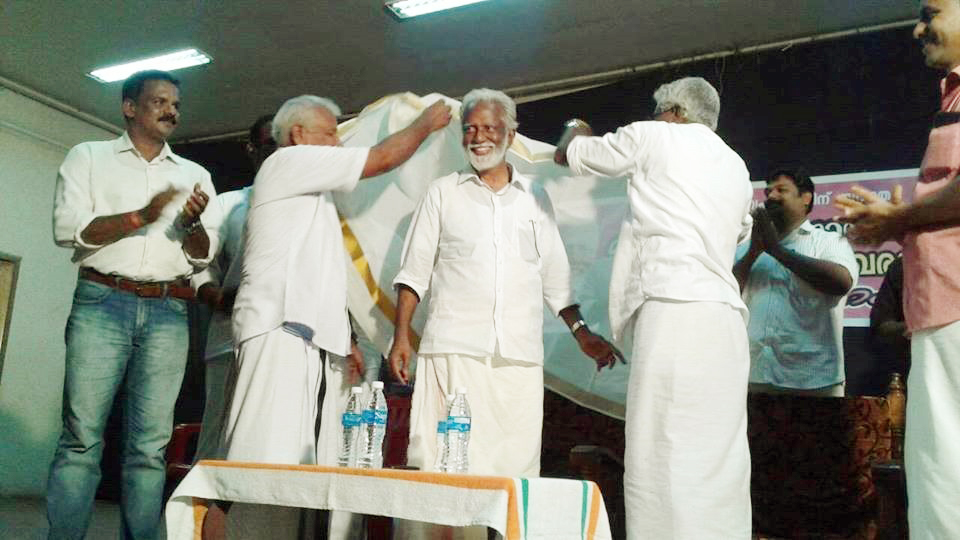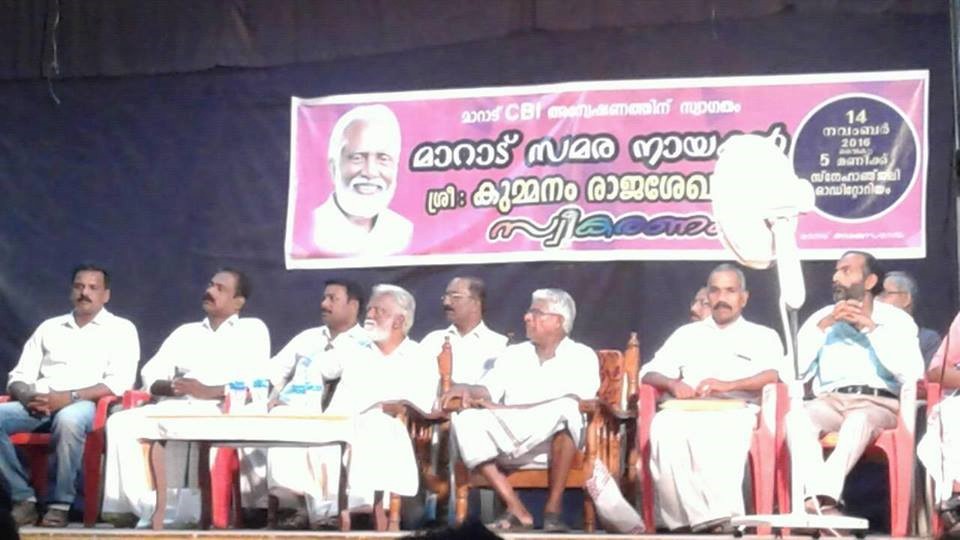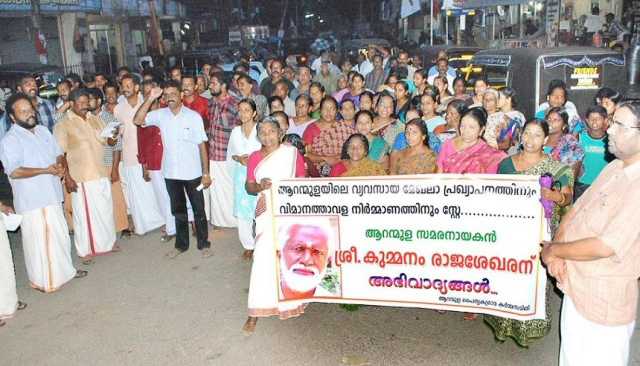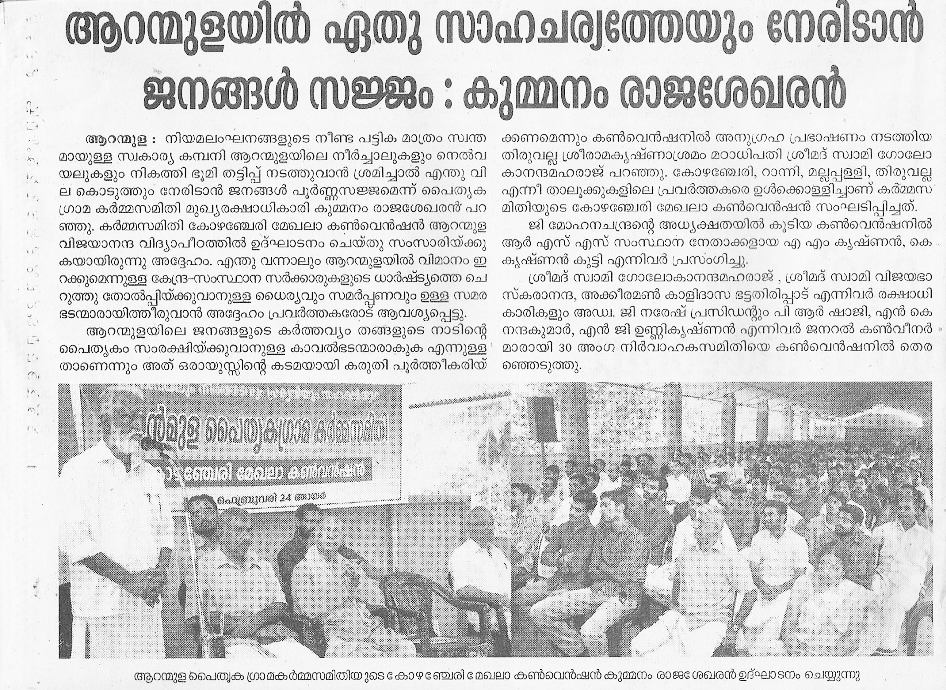Nilakkal, the touchstone of Hindu power
The news that someone had installed a Cross in the Nilakkal area of Sabarimala Poonkavanam spread like wildfire on 1983 March 24. The Christian church started spreading propaganda which were carefully prepared in anticipation. Leading newspapers such as Malayalam Manorama, Mathrubhumi, Deepika etc. published stories that the Cross found in Nilakkal dated back to 52 AD. Rejoicing on the so-called rediscoveryof the Nilakkal Church, which was one amongst the seven and a half churches founded by St. Thomas, resounded all over the state. This was followed by a steadystream of faithful Christians to the spot.
For a moment, not knowing what to do, the Hindu community hesitated. Newspapers published editorials and politicians issued statements in favour of the Cross, which helped the Christiansto gain upper hand in the campaign. The vicinity of the Nilakkal Mahadeva Temple overflowed with Christians. Signboards naming the road to the temple as St. Thomas Road and the Nilakkal hill as St. Thomas Mount were erected. A huge arch naming the spot as “Sleebanagar” was erected on the Sabarimala Road at Nilakkal Junction.
Kerala saw an unparalleled agitation.On November 15, after seven months of series of struggles, the Cross, purported to be of St. Thomas, was carried away unnoticed in a truck, and this incident became the touchstone of Hindu strength. But there, an injustice was being correctedthrough peaceful struggle.
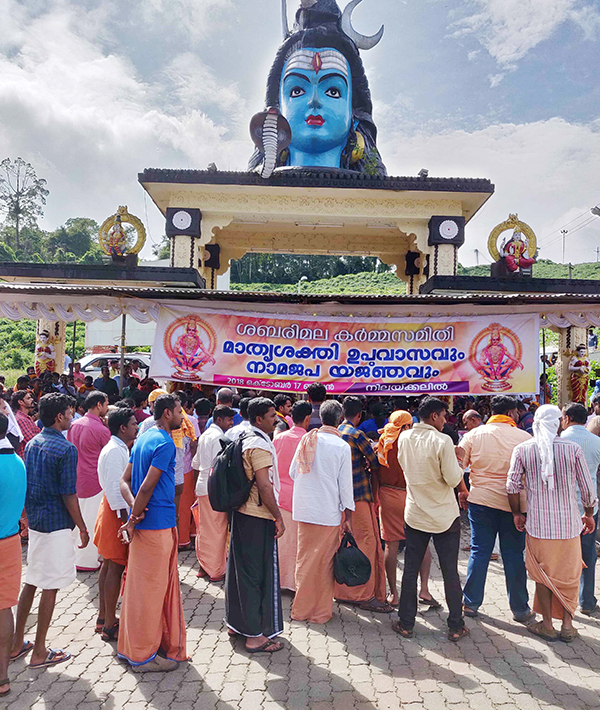
The Nilakkal agitation was the first of its kind in India in which the Hindu community agitated and won. Kummanam himself says: “On the morning of 25thMarch1983, I wasjust leaving home to go to the FCI office in Kottayam.A phone call from Parameshwarji came instructing me to urgently reach Ernakulam. Before long, I reached the Elamakkara office. Parameshwarji was sitting on a grass-mat laid on the floor in the office room and reading newspaper.”
“Seeing me, he folded the newspaper and started the conversation.” “Be seated. Didn’t you know about the encroachment at Nilakkal? Agitation programs should start immediately. The state committee members and district convenors of the Vishala Hindu Sammelanam have been asked to reach here immediately. Form the Action Council and start the strike.”
“Parameshwarji presented the details of the long drawn agitation programs to be carried out. He spelt out the well thought out and polished, written plan of action. The seeds of Nilakkal agitation was sown with foresight and a vision of what all needed to be done.”
It was decided to form an Action Council in the first week of April, after gathering all leaders of all the Hindu organizations in Thiruvananthapuram. Shri J. Sishupalan ji was in charge.A meeting was held to decide the formation of the Nilakkal Action Council. Thus the great Council of formidable Hindu leaders including Revered Swami Satyananda Saraswati, Shri T.N. Upendranatha Kurup (President of the Devaswom Board), Shri Kidangoor Gopalakrishna Pillai (NSS General Secretary), Adv. Sambasivan (SNDP Yogam Union President), Shri T.N. Bhaskaran (General Secretary, Pulaya Mahasabha), Shri D. Damodaran Potty (President, Ayyappa Sevasangham) and Adv. P.R. Rajagopal (President, Vellala Mahasabha) met.
“Swamiji presided. The meeting started. According to the agenda, the welcome-address should have been followed by the presidential and inaugural speeches. But Swamiji deviated from it and said, 'I humbly invite Parameshwarji for the introductory speech.' Parameshwarji introduced the topic. 'We are not dealing here with the issue of confronting the Cross or Christianity.The encroachment on Sabarimala Ayyappan's Poonkavanam is the destruction of Hindus' freedom of belief and worship. The truth of Ayyappan cannot be obscured or destroyed by aninvented story that St. Thomas came in 52 AD. There is a conspiracy behind the encroachment, there is also money, weapons and State-power. We should hold on to faith, dharma and truth and open the front of a fiery struggle. The Hindu community should be united.'”
“After listening to the introductory lecture, the doubts and confusion of the leaders dispelled. Kigangoor said, 'It was decided to respond to this issue only after clearing many doubts. Parameshwarji has answered all the questions in advance. So any explanation from me is irrelevant.'”
“The Nilakkal Action Council was formed with Swamiji asChairman, myself as the General Convener and Shri J. Shishupalan as Joint Convener. Parameshwarji was also in charge of presenting the resolution. After objective and rational analysis of the encroachment at Nilakkal, the resolution was discussed and passed.”
After the meeting, Swamiji was given the task to explain the decisions to the press. After conveying the proceedings of the meeting to the press, Swamiji asked Parameshwarji to announce the decisions. Addressing reporters without any hesitation, Parameshwarji explained: "There will be a strong mass agitation until the Cross erected on encroached land near the Nilakkal Temple in Sabarimala Poonkavanam is removed.The reason is not religious hatred.This is not a communal issue either. The forest land is being encroached upon by some people. The Palliyarakkav temple was demolished and a Cross erected nearby. Ayyappan's sacred Poonkavanam concept has been violated.The Hindu community cannot be idle by-standers.A struggle for truth, justice, existence and survival. is beginning here.”
“Questions arose from journalists: 'Isn't the Cross sacred to the Christians? Isn’t there evidence that St. Thomas came in 52 AD? Won't there be a communal riot?'
A barrage of questions.
Parameshwarji answered each without any hesitation, in no uncertain terms to the question whether the cross be allowed to be placed elsewhere in Nilakkal.”
'Not at Nilakkal, not anywhere in Poonkavanam. Poonkavanam is surrounded by 18 hills. Every hill has a Hill-Deity. 18padipuja takes place in that Deity concept. Hindus are reclaiming their right to freedom of religion by protecting the holy place they believe in. Don't see this as a communal issue. Not only that, no concept of Cross as a symbol of Christianity existed in 52AD. Those are troublemakers who pretend that something that did not exist, existed. The queries stopped.”
There was a clear vision of how each phase of the agitation should be like. There were precise calculations and intentions behind the setting of every program.” “The agitation intensified. According to a decision by the State Government, on May 28, the Cross placed near the temple at Nilakkal was moved to the West slope of the hill. The Devaswom Board accepted the decision of the government. NSS also agreed. They withdrew from the struggle. It was widely reported that the issue was settled. Confusion prevailed. On 1st of June, an emergency meeting to decide future programmes was held at the Samoohamatam hall in Kottayam. All the leaders participated. The atmosphere was turbulent due to the confusion and crisis. Swamiji ended his speech with general remarks.”
“As a proper crisis-manager and dharmarakshak, Parameshwarji stood up in front of the audience. “Chief Minister K. Karunakaran has conspired to use trickery in Nilakkal to defeat us. We have set out to save Sabarimala Ayyappan's Poonkavanam. There should be no compromise on this. Those who came along with us might return before attaining the goal. Lathis and bullets may pierce our chests. Kaliyuga-varada Sridharmashasta is with us. For so long, we have held satyagraha and public meetings throughout the length and breadth of the State and awakened the sentiments of the people. Now let's march towards Nilakkal. Let’s utter saranam and march to Nilakkal on the 4th of June to protect Ayyappan's sacred Poonkavanam like the apple of our eye'.”
“Listening to Parameshwarji's speech, the audience was moved with emotions. Saranaghosham echoed. Onward march to Nilakkal! When Swami Satyananda Saraswati announced that monks and leaders of Hindu organizations would participate in the Nilakkal march on the 4th of June and also that Swami Bhutananda Tirtha would lead, the nature and attitude of the struggle changed.”
“On 4thJune, Nilakkal March resulted in firing, usage of tear gas shells and lathi charge. Many people were injured. The government imposed a state-wide ban on the strike. About 6000 people were arrested.”
“Kanchi Shankaracharya Swamiji’s and Swami Chinmayanandaji’sresponses against the Nilakkal encroachment angered Chief Minister K. Karunakaran. He questioned the monks as to their right to interfere in aninternal issue of Kerala and mockingly queriedwhy they don’t get lost to the Himalayas toperform penance. He also questioned whether Hindus have a leader in Kerala.Parameshwarji came forward and gave a befitting reply.”
“Questioning the hypocrisy of Karunakaran, who bequeathed the Sabarimala Poonkavanam to encroachers, in visiting Guruvayoorappan every month, led to great controversy.The Nilakkal Action Council announced that devotees will meet Karunakaran in person at Guruvayur and express their concern and protest. When Karunakaran reached the temple on the 1st ofEdavam, thousands gathered in front of the temple chanting the Lord’s name.The temple premises was filled with devotees the night before. In the morning, when Karunakaran arrived with the security cordon set up by the police, the atmosphere was filled with chanting. People shoutingly requested the Chief Minister to protect Sabarimala.The devotees were pushed away by the police for making way forKarunakaran to enter the temple and have darshan. While he was coming out also, the public expressed their needs and grievances.”
“Later, Congress and CPM leaders expressed their protest against creating inconvenience to the Chief Minister.Shri Karunakaran said that trying to prevent him from having darshan was a violation of his right to perform ritual.Parameshwarji's response came immediately. “Karunakaran came to pray in front of Guruvayurappan. Devotees of Sabarimala Ayyappaswamy came before Karunakaran with prayers. There is nothing wrong with either. This is a sign and a warning.””
“Despite the ban, the agitation could not be suppressed. Day by day it became stronger. Guru Nityachaitanya Yati approached Parameshwarji for reqching a compromise. After making it clear that he would not back down, he (Yati) withdrew. Sarvodaya leader Shri M.P. Manmathan tried speaking to Parameshwarji several times. Thus a meeting between the representatives of Christians and Hindu was arranged. During discussions, the Hindu leaders took the firm stand that the only amicable solution was to remove the Cross from Poonkavanam.”
“After the talks between the Church leaders and M.P. Manmathan with the Swamiji and Parameshwarji, the Christian leadership decided to remove the cross. Thus, on the 15th of November 1983, Nilakkal issue, the popular agitation which lasted for almost seven-months was resolved after the Cross was removed from Poonkavanam.”
“The fact beyond the victory of the agitiation was the ability of Kummanam Rajasekharan to guide forward the Nilakkal movement, which had every probability of slipping into conflict and communal violence, through the path of peace and harmony. As the leader the popular Nilakkal movement, he rose to prominence. Kummanam became the answer to the then Chief Minister Shri Karunakaran’s query whether Hindus had a leader in Kerala and also with whom should be the Nilakkal issue discussed.”
“The rallying call against the practice of untouchability in Palazhi temple, near Thrissur, and Ilavoor ritual-hanging were the debut day scenes of Kummanam's social renaissance struggles. Kummanam was able to transform even isolated local movements into popular issues. Kummanam stands apart in it that he utilises popular movement and legal means and fights to the finish to achieve victory.”
